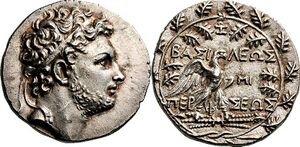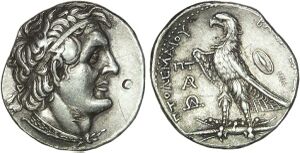نسر زيوس
نسر زيوس (باليونانية قديمة: ἀετός Διός, aetos Dios) كان أحد الصفات والتجسيدات الرئيسية لزيوس، رئيس الپانثيون الأولمپي.
النسور في القِدم
Eagles were considered the most prominent of birds in classical antiquity. Several legends attested to their unique qualities, such as Aristotle's claim that the sea eagle only raised the young who could look at the sun directly without their eyes watering, or Pliny the Elder's claim that they were immune to being struck by lightning, while the Geoponica claimed that they protected from hail.[1] They were considered endowed with oracular properties, and a divine bird, as messenger of Zeus and herald of victory.[1] In fact, Zeus himself is said to have transformed himself into an eagle on occasion.[1]
From these divine associations, the eagle came to be used as an emblem of several rulers, from the Achaemenids to Alexander the Great and the Diadochi, and finally of the Roman emperors.[1] Zeus being equated with Jupiter, the eagle holding Jupiter's lightning became the chief symbol (aquila) of the Roman legions.[2] The eagle was placed amongst the stars as the constellation Aquila alongside Lyra.[3]
الأساطير
هناك عدة مدارس فكرية تتعلق بأصل هذا النسر، وكلها قادمة من أساطير يونانية مختلفة.
آيتوس
في إحدى الروايات، كان آيتوس صديق الطفولة لزيوس، الذي أبقاه في معيته حين كان الرب مختبئاً في كريت من والده. بعد أن أصبح زيوس ملكاً، حوّلت هيرا آيتوس إلى نسر خوفاً من أن يكون زيوس في حالة حب معه. فجعل زيوس من النسر رمزه الأبرز والأكثر قداسة. في بعض الروايات، اِستـُبدِل آيتوس بگانيميد، الطروادي الذي اختطفه زيوس على شكل نسر.[4]
پريفاس

حسب Antoninus Liberalis، پريفاس كان ملكاً أسطورياً على أتيكا وكان ملكاً عادلاً، and a dutiful priest of Apollo. Zeus, however, became indignant because Periphas was revered and honoured as if he were Zeus himself, so Zeus wanted to destroy Periphas and his entire household. But Apollo interceded, and instead Zeus transformed Periphas into an eagle, making him king of all birds and guard of his sacred sceptre.[5]
خليقة گايا
In other accounts the eagle was in fact an ancient creation of the goddess Gaia. He appeared before Zeus at the start of the Titanomachy. Zeus took this to mean a good omen of victory, leading to him using the emblem of a golden eagle on his war standard:
...For so happy an omen, especially since victory did ensue, he made a golden eagle for his war standards and consecrated it to the might of his protection, whereby also among the Romans, standards of this kind are carried. — a translated excerpt from Fulgentius' "Mythologies" (Mythologiarum Libri III)
معلومات أخرى
According to others Zeus adopted the eagle when it first appeared to him before the Titan War as a sign of good omen. The eagle was later sent by Zeus to fetch the handsome youth Ganymedes to heaven to become the cupbearer of the gods.
الهامش
- ^ أ ب ت ث Hünemörder, Christian (2006). "Eagle". Brill's New Pauly. Brill Online. doi:10.1163/1574-9347_bnp_e103630.
- ^ Le Bohec, Yann (2006). "Ensigns". Brill's New Pauly. Brill Online. doi:10.1163/1574-9347_bnp_e410600.
- ^ "EAGLE OF ZEUS (Aetos Dios) - Giant Eagle of Greek Mythology". www.theoi.com. Retrieved 2022-03-09.
- ^ Kerenyi, Karl (1951). The Gods of the Greeks. London: Thames and Hudson. p. 95.
- ^ Antoninus Liberalis, Metamorphoses 6, pp. 118–121; Cook 1925, pp. 1121 ff..
المراجع
- Antoninus Liberalis, The Metamorphoses of Antoninus Liberalis: A Translation with Commentary, Edited and translated by Francis Celoria, Psychology Press, 1992. ISBN 9780415068963
- Cook, Arthur Bernard 1925, Zeus: A Study in Ancient Religion, Volume 2, Part 2, Cambridge University Press, 2010. ISBN 9781108021319.
- Smith, William; Dictionary of Greek and Roman Biography and Mythology, London (1873). "Periphas 5."
- Hemingway, Seán (2014). "The Eagle of Zeus in Greek Art and Literature". In Kevin F. Daly; Lee Ann Riccardi (eds.). Cities Called Athens: Studies Honoring John McK. Camp II. Bucknell University Press. pp. 89–114. ISBN 9781611486186.

